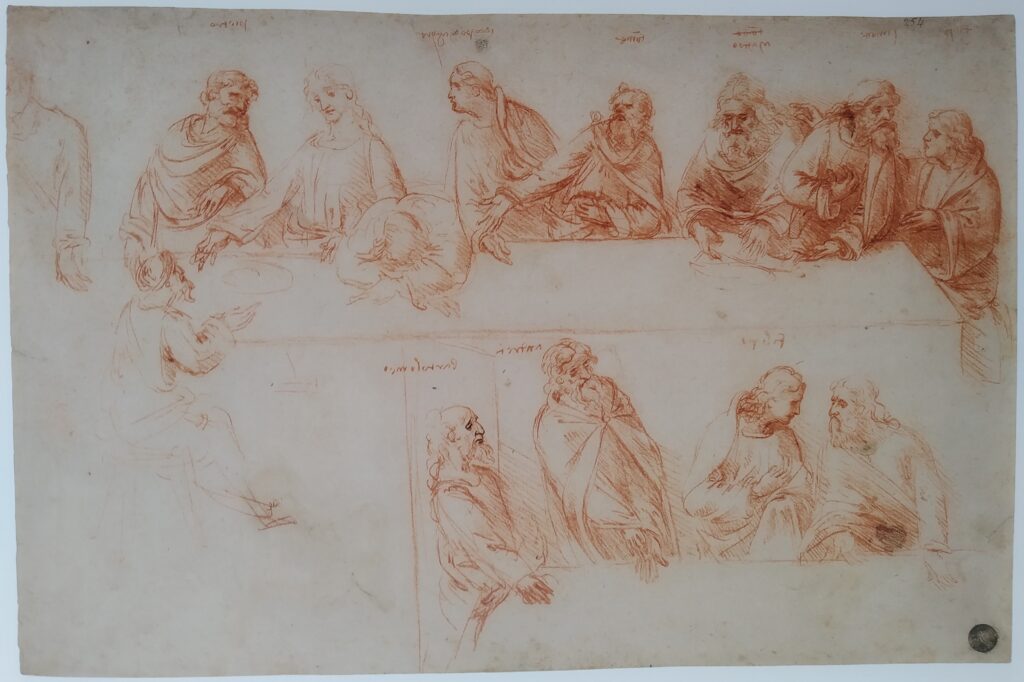Although I could not fully identify with all the thoughts of one Slovak painter, he brought several interesting ideas that I decided to explore, with a special focus on Leonardo’s preparatory study – the Last Supper drawing.
In the Last Supper painting itself, nature is depicted and the landscape in the background is presented as a paradise, a place where a person wants to go after a well-lived life. I particularly liked the idea that the apostles depict characters, or rather symbols and moments from the history of salvation.
Leonardo’s Last Supper is divided into the side of life (light) and the darker side [1]. This darker side carries heavier motives in the actions of the apostles and at the same time could represent the Old Testament. The author S. Lajda brought the idea that the crossed legs of Bartholomew at the beginning coincide with some typical depictions of the biblical Adam. He could also be depicted with his legs folded together, as for example in Hieronymus Bosch’s The Garden of Earthly Delights, in the allegory of Jesus’ crucifixion, or the crossed legs represent a kind of rejection of God’s original plan. At the same time, on the other side of Jesus, the side of light represents the New Testament, and according to Lajda, the gesture of the last figure can also represent a kind of consideration of possibilities, the palms weigh the situation while the fingers of the left hand count the options. This might represent the moment of the last judgment and is the counterpart of the beginning, the creation of man – Adam.
The figure of the apostle Andrew, raising his hands (in a defensive gesture), which reminded Lajda of the physiognomy of some depictions of Moses, convinced me that it could indeed be Leonardo’s planned inclusion of symbols, with the ten raised fingers representing the ten commandments of God. As these commandments were given twice to Moses.
At this point, I began to compare the depiction with Leonardo’s drawing of the Last Supper, where the apostle Andrew points to one hand with five fingers, which may represent the five books of Moses – the Pentateuch.

The apostle Bartholomew has his arms crossed and is probably sitting by the window and holding bread in his hand, which in the symbolism of Adam could mean “by the sweat of your face you will eat bread” [2]., while the position of the hands foreshadows the position of the legs in the painting itself.
At the same time, the motive of balancing is also present in the preparatory drawing, a figure marked with the name Mathew (Matteo) carefully lifts a thing similar to a basket. The weighing of goods by the toll collector is reflected and gets a developed meaning in the final work itself, while Matthew receives his own gesture counteracting the very pious gesture of Simon the Zealot as I have written earlier.
This view of the Biblical symbols, of the New Testament and the Old Testament, is supported by one figure at the end of the table being the oldest, and at the opposite end the figure is depicted as very young, if not the youngest. The apostle John remains propped up, hidden, lying on the table.
I am not sure which another symbols of characters Lajda still identifies [3]. He is a Slovak painter, illustrator and restaurateur [4]. I am trying to find a connection between Leonardo’s preparatory drawing and the Last Supper itself. When I imagine John the Baptist, who decreased himself and prepared the way for Jesus, I can imagine these symbols in the depiction of the apostle John, when the promised land – paradise – is revealed by his side. His artifacts include baptism by immersion in the Jordan River and a dove. In the preliminary drawing, his lying position and the shape of his hands do not exclude this. From this posture, he subsequently raises to his position in the Last Supper painting.
At this point it remains for me to explain yet some lines from Leonardo’s preparatory drawing, the depiction of the Apostle Thomas (Tome).

The object in his bag, which he is holding by his hand, will not be bread as I first assumed, but a book (for comparison, the bread in the drawing is held by an elderly figure on the edge). The book is also a clear attribute of the great writer of the New Testament – the apostle Paul. He, according to his own words, “the least of the apostles” [5], preached and wrote about the mysteries of the New Testament, and at the same time during Jesus’ earthly life, he was not part of his disciples.
Subsequently, also in the painting of Leonardo’s Last Supper, the unburdened gesture of the left hand and the exploratory finger of the apostle Thomas receive a new, additional meaning. Around the time the Apostle James the Greater lays down his life, the Apostle Paul begins to grow in ministry. [6]
Literature and comments
[1] “The Side of Death” – Leonardo’s Incessant Last Supper; p. 89; Leo Steinberg; 2001
[2] Genesis 3:19
[3] http://www.stanolajda.sk; https://www.leonardodavinci.sk; https://svetkrestanstva.postoj.sk/149893/co-vsetko-leonardo-ukryl-do-svojho-diela-a-ako-na-to-prisiel-maliar-zo-slovenska; https://www.youtube.com/watch?v=fWC4jm1Baf4 ;
[4] Stano Lajda studied Painting restoration at the Academy of Fine Arts and Design in Bratislava, Slovakia. (1979 – 1985).
He dedicated his diploma thesis in Art History to artistic-historical analysis and restoration work on Leonardo’s Last Supper, which in 1985 already had been going on for 6 years. Leonardo’s mural painting has been his lifelong interest.
[5] 1 Corinthians 15:9
[6] Acts 12
